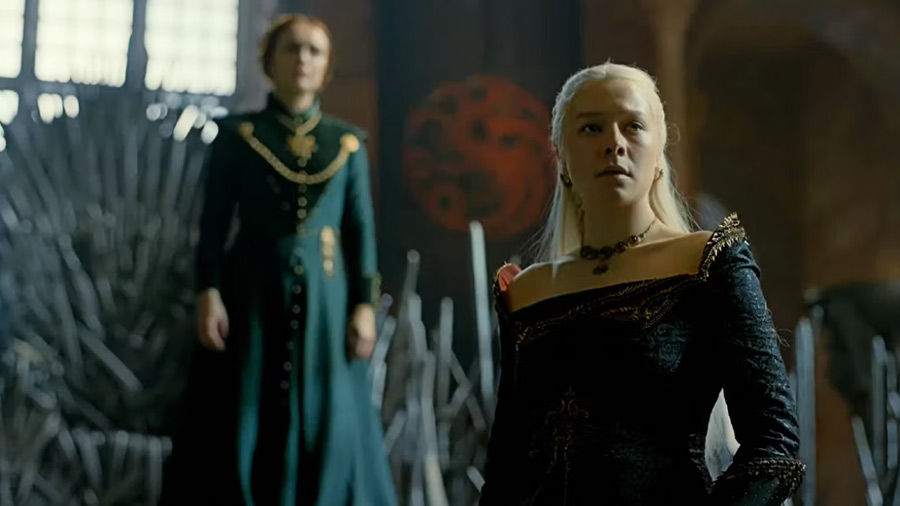In the final episode of Game of Thrones’ infamously rushed eighth season, Drogon melts the Iron Throne, the most coveted seat in all of Westeros, into slag once he realises that his mother, Daenerys Targaryen, can no longer sit on it. Some three years later, the Iron Throne is back – seemingly larger, sharper and more imposing – as HBO attempts to find a successor to Game of Thrones by going back in time. Two hundred years, to be precise.
With House of the Dragon, which premieres on Disney+Hotstar on August 22, the GoT universe dials back to the origin story of the Targaryens, focusing on the events leading up to and including the Targaryen war of succession, hailed in GoT folklore as the ‘Dance of the Dragons’.
On face value, House of the Dragon is set to be a litmus test for HBO’s emulation of the Marvel model, wherein a franchise becomes a never-ending universe of action, drama and controversy. Five spin-offs (including one centred on Jon Snow) are expected to follow House of the Dragon in building the GoT legacy. But even before the new show can fulfil its role as the canary in the content mine, it needs to redeem the GoT franchise from its nadir – a woefully disappointing eighth season that turned the show’s foremost heroine, Daenerys, into a medieval dictator overnight, made the ingenious Lord Varys die as a pitiful dimwit, gave Jon compulsive cognitive dissonance and placed Bran Stark in charge of the Seven Kingdoms simply because “who has a better story than Bran?” (at least eight other characters, perhaps).
Reports indicate that with far more time and resources at its disposal, House of the Dragon will be far better paced and more structurally coherent than GoT’s last season. Unlike the eighth season, which had no reference material from George R.R. Martin — the writer whose series, A Song of Ice and Fire, inspired GoT — to count on, House of the Dragon has been shaped with tremendous allegiance to Martin’s novel on the Targaryens, called Fire and Blood.
So what does House of the Dragon need to do to bring alienated fans back on board? Here’s a formula that has served GoT well and would stand its prequel in good stead too.
Develop character arcs, not reduce them to caricatures
To begin with, it must do justice to character arcs and not reduce them to caricatures at the most pivotal moments. In doing so, they could follow the lead of Theon Greyjoy, who went from evoking indifference to disgust to pity among viewers, instead of the trajectory reserved for Daenerys, Varys or even Jon.
Epic conversations between leads
With a narrower horizon to work with – expect most scenes to revolve in and around the court – House of the Dragon should also offer an ample supply of “great conversations in elegant rooms”, which used to be a hallmark of the initial GoT seasons. This means that fans should not be lamenting over missed opportunities when it comes to epic exchanges between leads. For context, imagine what Season 8 could have been with a fearsome dialogue between Cersei Lannister and Daenerys and a proper face-off between Jon and the Night King.
Intricate storytelling that dovetails characters
The next element House of the Dragon should get right is the intricacy of the storytelling, which used to be what set GoT apart from most other sweeping fantasies. For this to happen, the Targaryen characters must be dovetailed using common themes, motives and traits, which helped bind families like the Starks, the Lannisters and the Tyrells.
In other words, viewers should know what the Targaryens stand for, both individually and collectively, in the absence of which they can neither root for nor resent the family with any degree of sincerity. The key question that will define House of the Dragon is whether Princess Rhaenyra, the old king’s first born, gets to become the first woman to rule over the Seven Kingdoms. In answering this question, Rhaenyra’s relationships with her father (King Viserys I) and uncle (Prince Daemon) will be paramount, leaving no room for compromise in the struggle between power and love, ambition and faith, one woman’s resolve and an entire civilisation’s patriarchy.
Shock us when we’re least expecting it
Lastly, House of the Dragon should revert to GoT’s formula of shocking the audience when they least expect it. Not all shocks, after all, are surprises– Arya Stark killing Walder Frey or Cersei and Jaime Lannister dying together under a heap of debris were predictable plot twists as compared to bolts from the blue like the Red Wedding and practically everything the Night King did up until the last season.
If House of the Dragon can breathe enough fire back into the GoT franchise, it could herald the next golden age of fantasy television, spawning a new dynasty for HBO. With Amazon Prime’s The Lord of the Rings set to premiere in early September, the prospect of two of the most expensive and expansive shows ever made slugging it out every week is a tantalising one. During its first run between 2011 and 2019, GoT transformed what blockbuster television looked like. The revolution might be slower, but steadier, the second time around.











